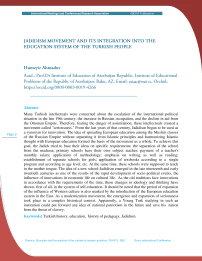Jadidism movement and its integration into the education system of the Turkish people
Автор: Ahmadov H.
Журнал: Science, Education and Innovations in the Context of Modern Problems @imcra
Статья в выпуске: 2 vol.4, 2021 года.
Бесплатный доступ
Many Turkish intellectuals were concerned about the escalation of the international political situation in the late 19th century, the increase in Russian occupation, and the decline in aid from the Ottoman Empire. Therefore, fearing the danger of assimilation, these intellectuals created a movement called "seriousness." From the last years of that century, Jadidism began to be used as a synonym for innovation. The idea of spreading European education among the Muslim classes of the Russian Empire without separating it from Islamic principles and harmonizing Islamic thought with European education formed the basis of the movement as a whole. To achieve this goal, the Jadids tried to base their ideas on specific requirements: the separation of the school from the madrasa; primary schools have their own subject teacher; payment of a teacher's monthly salary; application of methodology; emphasis on writing as well as reading; establishment of separate schools for girls; application of textbooks according to a single program and according to age level, etc. At the same time, these schools were supposed to teach in the mother tongue. The idea of a new school-Jadidism emerged in the late nineteenth and early twentieth centuries as one of the results of the rapid development of socio-political events, the influence of innovations in economic life on cultural life. As the old traditions face innovations in accordance with the requirements of the time, these changes in ideology and thinking have shown, first of all, in the system of self-education. It should be noted that the period of expansion of the influence of Western culture is also marked by the introduction of the European education system in the East. As a modernization movement, the emergence and expansion of seriousness took place in a complex historical context. Apparently, a Young Turk studying in such an institution could put forward any idea of national patriotism in the future and save his nation from the threat of slavery.
Turkish history, education, history of pedagogy, Jadidism
Короткий адрес: https://sciup.org/16010081
IDR: 16010081
Текст научной статьи Jadidism movement and its integration into the education system of the Turkish people
Acad., Institute of Education of Azerbaijan Republic. Institute of Educational Problems of the Republic of Azerbaijan: Baku, AZ, Email: , Orchid:
Indeed, as the main task of the Turks' independence, the idea that "the condemnation of a ruling nation and the extinction of a condemned nation stems from lack of schooling" was widely echoed.
The state of the old Muslim education system did not allow it to be maintained. In addition to religious ideas, the school curriculum included the study of mother tongue, arithmetic, geography, and other secular subjects. The acquisition of worldly knowledge was a requirement of the time. The school was to become a center for the promotion of science and education. One of the demands of the representatives of the Jadid movement was to change the content, form and methods of teaching in schools. The pedagogical thinking of the new era had already begun to take its place in school practice. Enlightenment and mastering modern sciences seemed to be the way of salvation of the Turkish nation (70).
Jadidism, as a liberal-bourgeois religious reform movement, was already widespread among Russian Muslims. Newly published encyclopedias state the following about Jadidism: Jadidism emerged in the late 19th and early 20th centuries as a socio-political movement aimed at enlightenment and cultural reform among Muslims in the Volga region, Crimea, the Caucasus, and Central Asia. It was based on issues such as the renewal of the old system in Muslim schools, the introduction of new teaching methods and techniques, the inclusion of a number of secular subjects in school curricula. Proponents of Jadidism consider it necessary to carry out some reforms in Islam, its adaptation to modern development, the development of national art and literature, After the movement in Russia in 1905-1907, they went a step further, expressed 10 their views on reforms in the political system, and organized to implement their ideas. The "Union of Muslims", which did not leave a big mark in history, became the "Islamic Council" in Central Asia after 1917, and the "National Party" in Crimea. During the Soviet era, some of them were in solidarity with the new government, while others joined the whites, the oppressors, or emigrated abroad, not accepting the Soviet ideology. Thus, the Jadid movement that emerged among Russian Muslims in the second half of the 19th century wanted to see culture and education meet new requirements. Some of them strongly considered it expedient to replace the content, forms and methods of teaching in the national school, as well as in madrassas with new ones.
Wow, is this a new lesson ?!
No… x! Yo… x! son, this school-rebellion!
Science, Education and Innovations in the context of modern problems, 05 NOV, 2021 Baku, International Conference
Discussion

Indirectly, however, it was a reform program designed against both old religious rules and Russian colonialism. Of course, Jadidism in the society was not initially accepted as a progressive reform program or a pedagogical trend in the full sense of the word, and faced certain obstacles. It is known that during this period, because schools were closely linked with religion, any innovation in education could directly affect the propagation of religion and its content. Indeed, Jadidism meant education, culture, language, and ultimately religious reform. The general position of the members of the society trying to prevent the expansion of the new method of teaching is expressed in the poem of the great Azerbaijani satirist MASabir as follows:
Mullah is not the one who teaches this!
Beware, this is a new devil!
Stop running, son, it's bloody!
At the beginning of the 20th century, reforms began in the old mullah schools and madrassas. In addition to Sharia and religion classes, secular sciences were taught in schools. The number of modern systematic schools in Europe increased. The first Russian-Muslim school opened in Baku in 1887 by the great enlighteners SM Ganizadeh and H. Mahmudbeyov was the beginning of these secular schools. There used to be 42 students here. In 1912, when the anniversary of those schools was celebrated, the number of Russian-Azerbaijani schools of this type reached 9. In addition, 8 Russian-Azerbaijani girls' schools and one-grade schools also functioned as new method schools. By this time, the number of students had reached 2,249. 337 of them were girls. Of course, these figures were not satisfactory. There was a serious need to expand the network of modern schools.
The problem was that the tsarist government, which did not allocate funds to schools, did not take seriousness seriously. The national intelligentsia, on the other hand, took the opposite position, believing that this was the only way to help educate the people. They sharply criticized the enlightenment policy of the tsarist government, called for the enlightenment of the people by the tsarist government, the opening of new democratic, secular schools, the elimination of illiteracy, science, culture and so on. they said they were not interested in organizing. At the beginning of the twentieth century, educators, seeing the exceptional role of the new school for the development of our people, had to fight with those who wanted to hinder its development. Representatives of the old world, not wanting to give up suddenly in the face of innovation, they Page 11 tried to prove that the opening of a new methodical school was against religion. The educators explained that the new method of opening schools was preferable, where teachers taught using the sound method in the classroom and the alphabet. Enlighteners also had some ideas about didactics, an important subject of pedagogy. They noted that in the new schools, the teacher's use of visual aids in the classroom makes it easier for students to understand the lesson. In such a teaching process, the teacher's preference for strengthening knowledge and mastering scientific knowledge through education was a real success. Here, teachers explained that they taught using the sound system in the classroom and the alphabet. Enlighteners also had some ideas about didactics, an important subject of pedagogy. They noted that in the new schools, the teacher's use of visual aids in the classroom makes it easier for students to understand the lesson. In such a teaching process, the teacher's preference for strengthening knowledge and mastering scientific knowledge through education was a real success. Here, teachers explained that they taught using the sound system in the classroom system and the alphabet. Enlighteners also had some ideas about didactics, an important subject of pedagogy. They noted that in the new schools, it is easier for students to understand the lesson if the teacher uses visual aids during the lesson. In such a teaching process, the teacher's preference for strengthening knowledge and mastering scientific knowledge through education was a real success.
Jadidism, based on such progressive ideas, is divided into two historical stages according to its spread and development:
1. From the 1980s until the First Russian Revolution, the government was loyal to the movement, and the general public was cautious;
Science, Education and Innovations in the context of modern problems, 05 NOV, 2021 Baku, International Conference

-
2. Between 1905 and 1907, as mentioned above, as mentioned above, it had already taken on a socio-political and socio-cultural character outside of school reform and had received material and moral support from society.
It should be noted that Abdulqayyum Nasiri (1824-1907), who tried to teach "European subjects" to the people in his own language and began to write the first textbooks in this field, was the second modern teacher of the Turkic world. However, Ismayil bey Gaspirali was the founder of the school, which was distinguished in the whole Turkic world by its reformist activity and was first taught in the Turkic-Tatar world. During his travels to the West, Gaspirali adopted a new method of school system founded by the famous Swedish pedagogue Pestalozzi, and after returning to his homeland, he began to spread this method among Muslims living in Russia. His newspaper "Tercuman", published since 1883, was the most powerful tool in spreading this new method among the people. "Translator" newspaper, starting from Crimea, covers the whole Caucasus, Kazan, Siberia, Turkestan, and even China, Iran; it was also widespread in Egypt and Turkey. The main goal of the newspaper was "unity in language, thought and work." Ismayil Bey also spoke out against the policy of assimilation and Russification, writing that cooperation with the Russians would be more appropriate on the basis of established conditions. He believed that the new methodical schools would raise the cultural level of the Turks.
These were, first of all, the fruits of the seeds sown by MFAkhundzadeh in this way, and those seeds slowly sprouted. They were also reflected in the press and school issues. In this regard, the prominent literary critic F. Kocharli wrote: “Those who write new books, compile methods, give newspapers and magazines, each try to use a kind of spelling and method-distortion so that the reader can read his writings correctly and understand his thoughts and ideas. The late Ismail bey Gaspirinski, who in the past did not pay attention to the flaws and changes of the Muslim 12 alphabet, has inadvertently violated the grammar and split the words, whether Turkish, Arabic or Ajami, in a new style with articles in Muslim letters. wrote a story. This revolution, which took place in the method of spelling and was observed in our article, the founder of this reform was Mirza Fatali. Of course, this important issue will not be resolved for a long time, and the alphabet of Muslims will be changed and simplified, like the alphabet of other civilized nations, and will be a perfect and glorious tool for the pursuit of knowledge and enlightenment: God willing.
Apparently, the development of modern methodological schools made the most advanced intellectuals of the time think. M.A. Rasulzadeh also saw this aspect and correctly assessed it. He wrote: “A new era was beginning in the lives of Turks and Azerbaijanis in Russia. The national-cultural movement revived by Mirza Fatali Akhundov, Hasan bey Zardabi and Ismail Gaspirali was advancing, and this movement was entering the stage of a political legal battle.

The revival, which began with the Methodist movement, soon paid off. Thus, if the last statistical report of the Caucasus Enlightenment Control once said that 1 out of 500 children of Caucasian Muslims studied, in 1910 more than 20 million Muslims living in Russia published more than 100 books, 14,000 printing houses were opened, and the number of newspapers and magazines increased. are. Among the Muslims were more than 20 graduates of Russian universities, including more than 200 educated people educated in Western Europe. Such a development was an important step in the expansion of national and cultural construction. If in the first stage of Jadidism the main task was to spread modern books from Bakhchisaray to China, from Kazan to Iran, soon Kazakhstan, Similar schools began to open in Kyrgyzstan and Turkmenistan. The
Science, Education and Innovations in the context of modern problems, 05 NOV, 2021 Baku, International Conference opening of the "Usuli-Jadid" school in Samarkand in 1893 was welcomed by intellectuals. Such schools were opened in Andijan in 1897 and in Tashkent in 1901. Since 1907, interest in new methodical schools has increased in Azerbaijan. Teachers praised the new teaching method, which greatly facilitated the acquisition of primary education. Thus, the Methodist schools, which began on the Crimean peninsula, had already crossed the Ural Mountains and reached Central Asia, from there to Tabriz and Tehran. Such widespread use of the new method played an important role in the development of education and culture of the Muslim peoples.
Conclusion
Ismayil Bey considered it important to apply a new method in the field of education for the development of the Turkic-Muslim peoples. Ismail Bey, who understood the primary role of education in the example of the West, considered it a formula that scientists would increase, that they would revive enlightenment, and that in turn it would free the whole nation from backwardness. He was based on the idea that religious and secular sciences should be taught in parallel, and that education should serve the teaching of the mother tongue. In the "modern-methodical" schools, where the sound method will be used, it was planned to apply a specific period of education, age limit, and exact class hours. Examinations were also planned in methodological schools aimed at the complete abolition of corporal punishment. Ismayil Bey, who prepared textbooks for students and teachers in order to implement all these ideas, of course faced the obstacles of old-fashioned people. Despite all the difficulties, he opened modern schools in Bakhchisaray and expanded his activities around Central Asia, India and Egypt.
Page 13
After the Russian Muslims were able to realize the idea of Jadidism, general congresses were held, and the importance of opening mother-tongue schools was reflected in the program document.
Despite the reactionary policy of tsarism in the field of public education, as a result of progress in the economic and social life of the country, the consistent struggle of leading intellectuals, the network of modern schools in Azerbaijan was expanding year by year. During this period, the reformist intellectuals of Azerbaijan, following in the footsteps of KDUshinsky, AOChernyayevsky and R. Afandiyev, began to compile new textbooks in their native language.


